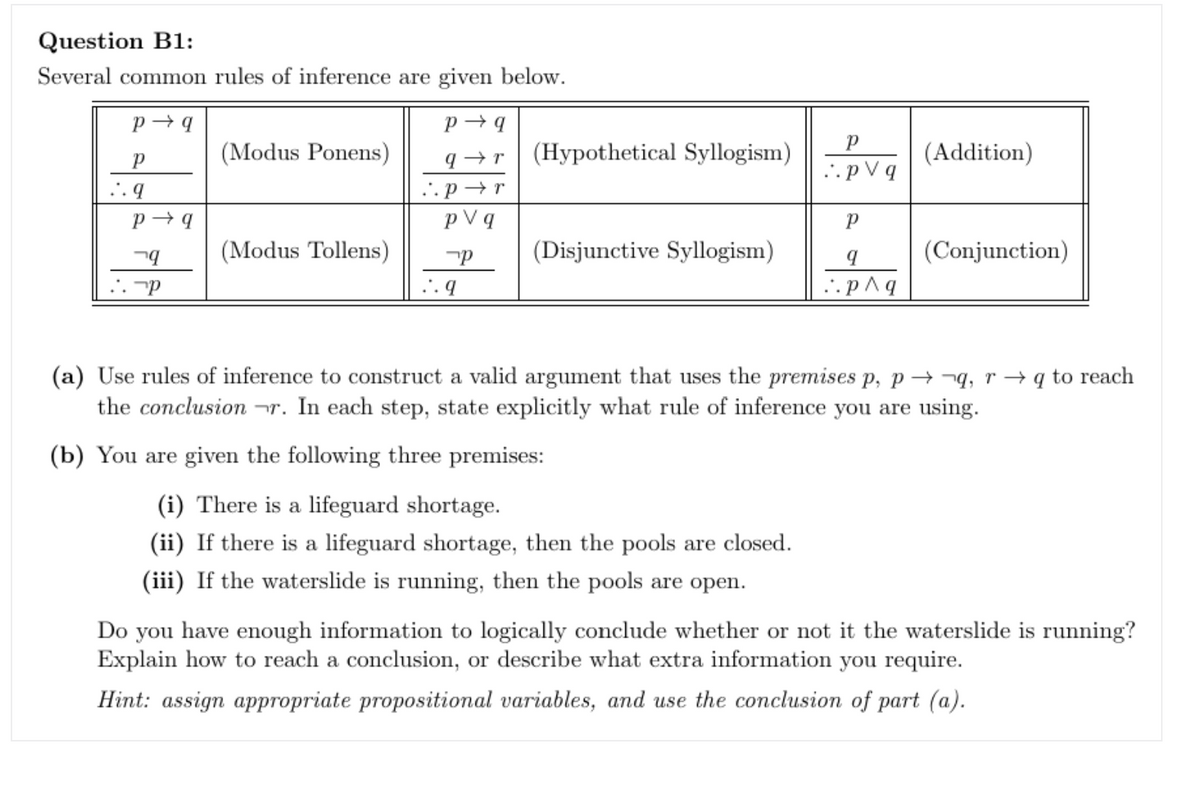(a) Use rules of inference to construct a valid argument that uses the premises p, p→¬q, r→q to reach the conclusion-r. In each step, state explicitly what rule of inference you are using. (b) You are given the following three premises: (i) There is a lifeguard shortage. (ii) If there is a lifeguard shortage, then the pools are closed. (iii) If the waterslide is running, then the pools are open. Do you have enough information to logically conclude whether or not it the waterslide is running? Explain how to reach a conclusion, or describe what extra information you require. Hint: assign appropriate propositional variables, and use the conclusion of part (a).
(a) Use rules of inference to construct a valid argument that uses the premises p, p→¬q, r→q to reach the conclusion-r. In each step, state explicitly what rule of inference you are using. (b) You are given the following three premises: (i) There is a lifeguard shortage. (ii) If there is a lifeguard shortage, then the pools are closed. (iii) If the waterslide is running, then the pools are open. Do you have enough information to logically conclude whether or not it the waterslide is running? Explain how to reach a conclusion, or describe what extra information you require. Hint: assign appropriate propositional variables, and use the conclusion of part (a).
Trigonometry (MindTap Course List)
8th Edition
ISBN:9781305652224
Author:Charles P. McKeague, Mark D. Turner
Publisher:Charles P. McKeague, Mark D. Turner
Chapter8: Complex Numbers And Polarcoordinates
Section: Chapter Questions
Problem 2RP: A Bitter Dispute With the publication of Ars Magna, a dispute intensified between Jerome Cardan and...
Related questions
Question
discrete math

Transcribed Image Text:Question B1:
Several common rules of inference are given below.
P→q
P
..q
P→q
q
P
(Modus Ponens)
(Modus Tollens)
P→q
q→r
..pr
pv q
P
..q
(Hypothetical Syllogism)
(Disjunctive Syllogism)
P
..pv q
P
9
..p^q
(Addition)
(Conjunction)
(a) Use rules of inference to construct a valid argument that uses the premises p, pq, r →q to reach
the conclusion r. In each step, state explicitly what rule of inference you are using.
(b) You are given the following three premises:
(i) There is a lifeguard shortage.
(ii) If there is a lifeguard shortage, then the pools are closed.
(iii) If the waterslide is running, then the pools are open.
Do you have enough information to logically conclude whether or not it the waterslide is running?
Explain how to reach a conclusion, or describe what extra information you require.
Hint: assign appropriate propositional variables, and use the conclusion of part (a).
Expert Solution
This question has been solved!
Explore an expertly crafted, step-by-step solution for a thorough understanding of key concepts.
This is a popular solution!
Trending now
This is a popular solution!
Step by step
Solved in 3 steps with 3 images

Recommended textbooks for you

Trigonometry (MindTap Course List)
Trigonometry
ISBN:
9781305652224
Author:
Charles P. McKeague, Mark D. Turner
Publisher:
Cengage Learning

Elements Of Modern Algebra
Algebra
ISBN:
9781285463230
Author:
Gilbert, Linda, Jimmie
Publisher:
Cengage Learning,

Trigonometry (MindTap Course List)
Trigonometry
ISBN:
9781305652224
Author:
Charles P. McKeague, Mark D. Turner
Publisher:
Cengage Learning

Elements Of Modern Algebra
Algebra
ISBN:
9781285463230
Author:
Gilbert, Linda, Jimmie
Publisher:
Cengage Learning,